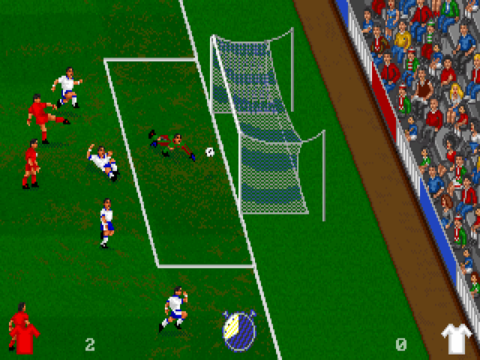
Kick Off 3: European Challenge
Written by: Rik
Date posted: July 5, 2020
- Genre: Sport
- Developed by: Anco
- Published by: Anco
- Year released: 1994
- Our score: 4
Despite not being a particularly memorable or distinguished football game, Kick Off 3: European Challenge remains significant to me for a couple of reasons. It was the first PC game I ever bought, even before my family actually had a DOS machine of our own, and it accompanied me on many trips to the houses of PC-owning friends, many of whom did not, unfortunately, like football. On one occasion, my hopeful suggestions did translate into a brief session of play, although it was curtailed shortly afterwards when my host’s father burst in and admonished us in the strongest possible terms for failing to acknowledge his (rather puritanical) policy that no games could be installed on his PC from disks that had been inside another computer, demanding instant deletion and a virus scan.
A demo of KO3: EC was also included on the cover disk of very first issue of PC Zone that I ever bought (March 1995, Issue 24, Dark Forces cover), which featured a review of the full game by future editor Jeremy Wells. I was reminded of this review recently, upon discovering that it had been plagiarised in its entirety and published on one of those dirty great big download sites that you sort of wish didn’t exist but then you end up visiting anyway because they have something you need. (I guess it’s hardly surprising that those with a relaxed attitude towards intellectual property might view old game downloads and copied reviews as two side of the same coin, but to me, the latter, without acknowledging the source, is entirely without honour).
The text of that review was immediately familiar to me, because it was what had convinced me to buy the game in the first place. It ticked all of my football game boxes: a moderately positive write-up that acknowledged multiple rough edges, particularly in the presentation, but also suggested that a deep and playable title lay underneath. PC football gaming was in a rough place at the time and so this was just about as good as it got.
The game’s depths, however, remained all too hidden to me, even after securing regular access to a PC. However, I held onto the possibility that it was something about my setup, most specifically the lack of a supported four-button joypad, which meant that the full range of moves and deeper complexities remained out of reach. Curse these two button joysticks! With such a limited controller at my disposal, of course Kick Off 3: European Challenge would seem like a sloppy, unfathomable mess. But now is the time of reckoning. Joypads have a million buttons and everything works with DOSBox. Right? Right?
Well, no. It turns out Kick Off 3: European Challenge is such a fussy pig of a game that fancy modern jiggery-pokery will not, in fact, automatically deliver the means to resolve this 25 year-old stalemate. What it can do, however, is replicate the exact same experience with the game that I had in the mid-90s: two buttons, or nothing (the game, inexplicably, does not support keyboard controls for gameplay, so keys or a keymapper are out of the question). But I’m a stronger/better/sadder man now, and, this time, I refuse to give in. I accept your terms, Anco! [They shut down in 2003, you berk – Ed.]
A bit of admin before we go much further: this game is part of the official continuation of the Kick Off series after co-creator Dino Dini left to develop Goal! for Virgin Software. While Dini’s effort retained Kick Off’s traditional top-down viewpoint and gameplay, adding real player names, teams and leagues, Anco’s game opted for a switch to the more visually-appealing side-on view. European Challenge also isn’t the first attempt at continuing the series – there was, in fact, a vanilla release months earlier called, simply, Kick Off 3. This initial version was historically rather tricky to track down, to the point at which I started to doubt its existence, but I can confirm that it is indeed a real thing, and certainly an interesting point of comparison: while European Challenge is certainly the more refined effort, and includes club as well as international sides, there are some odd retrograde changes, including the removal of real player names and ethnicities (more on which here).
Anyway: to the game at hand. The menus are indeed awful and unintuitive, although ultimately you either adopt a hyper-vigilant stance to guard against failed saved games and/or accidentally starting a match with the default line-up and tactics, or learn to live with it. The latter is quite annoying because they’re pretty much always wrong anyway, with midfielders and forwards out of position, regardless of formation. At this point, you’ll also be able to note the ridiculous fake player names, which will nevertheless be recognisable to fans of 90s football, despite ludicrous deliberate misspellings. You do always have the option of tinkering with your tactics during the game, although accessing the in-game menu does appear fraught with danger and is liable to make the game crash. (In fact, on that note, you should also make sure to turn injuries off, as fouls are legion and substitutions also a frequent source of crashing). In line with footy titles of similar vintage, you can either play in a one-off match, or start a cup or league.
Out on the pitch, the presentation remains on the rustic side, with a sense of cheery underdog amateurism the overriding aesthetic. Player models and animations aren’t particularly impressive, and kits are fairly basic (stripes are notable by their absence), while sound effects are okay, but afflicted by a particular and unusual repetitive tick in the crowd noises, which always bothered me at the time. It’s unvarnished, early-90s fare, mid-table stuff in terms of looks and sounds, and a long way behind the polished presentation of EA’s first FIFA title.
And what of the great untapped potential underneath? First impressions are of hectic, uncontrollable chaos, which seems hard to reconcile with the promise of deep and subtle gameplay, as suggested by the manual. Ah yes, the manual: my second source, other than the Zone review, in terms of raising expectations. It’s important to acknowledge the importance, in times gone by, of a game’s supporting documentation, when it came to conjuring an impression of the experience ahead, particularly if, as in my case, hands-on time with the game itself lay some distance into the future. And, of course, manuals could be filled with completely unsustainable nonsense that would never actually have to tally with your experience of the game.
My goodness, the picture this rather long and detailed instruction booklet painted of the footy-based fun you’d have in European Challenge. From mentions of one-touch football and advanced moves such as volleys and overhead kicks, to the extensive player attribute system with liberos and playmakers: in 90s terms, you’d expect a Ruud Gullit of a game, rather than the equivalent of Tony Cascarino. There was even loose talk of a data disc and some hype about how the engine was designed to power another future sequel to a Dini-era game, Player Manager 2 (a story for another day, perhaps).
The list of moves is extensive, although so extensive that even with the elusive riches of a four-button pad at your disposal, multiple similar commands are mounted to one button, with a combination of button presses required for further actions. You do wonder whether some of these (for example: kick, shoot, pass, chip, clear, cross, high kick and hard kick) could have been consolidated, although in effect they sort of are, if you play with two buttons. In which case, we’re in a world of distinguishing between button taps and presses, and it’s genuinely hard to tell what you’re doing, beyond certain fundamentals: one button for passing (tap) and kicking (hold), another for dribbling (tap) and chipping (hold).
It’s a curious affair, combining the eccentric fast pace of previous Kick Off games with more stodgy and unresponsive controls. On the plus side, on medium speed and control system settings, there’s a happy balance between the more modern sticky-foot system and old-school seat-of-the-pants dribbling, and, when combined with the ‘push ball ahead of you’ button, there’s some potential for some skilful and enjoyable running with the ball. Doing things while in possession, and winning it back, is more problematic. Unless the computer judges that a pass is ‘on’, pressing the button does not seem to release the ball, and in general a passing game isn’t on the cards. Shooting is also a bit automated, unlike in the likes of Kick Off 2 and Sensible Soccer, in which curling a big shot into the top corner felt like a glorious piece of skill. Tackling is ridiculous, and sliding tackles invariably lead to a foul. You can turn fouls off, of course, but then matches become a chaotic free-for-all. With them on, it’s penalties and red cards a-plenty.
There’s a broadly playable arcade footy game here, but that’s all. Most of the promises in the manual are, frankly, bollocks, which I should have realised a long time ago. One tell-tale sign is that you don’t see your opponents doing too many clever things that you can’t, other than punting crosses into the box that no one ever latches onto, or passing across your keeper for a goal (a tactic mined mercilessly in one game featured in the video clips here). But, generally, they adopt the same guileless tactics as you.
I’ve mentioned elsewhere that when you demonstrate football understanding, it shows, and you can get away with quite a lot: hence, why Pro Evolution Soccer was able to beat the more adequately-resourced FIFA series for so long in the 00s, or even how New Star Soccer 5 was able to get around having no licenses. Here, there are signs all over the place that this isn’t a game by people who really understand football. Fake player names, for example, may be unavoidable. But playing a league reveals that several teams are missing, that you only play each opponent once, and get two points (not three) for a win. Easy things to get right, you’d think. On the pitch, you’re given no visual indicator of the name of the player on the ball, except when a foul is committed, when you’re given their number. There’s no pitch radar, either, and corners and set pieces are unfathomable. Players have attributes, but it’s hard to tell based on their performance: for example, players with pace seemingly run at the same speed as everyone else.
These are things that even Kick Off 2 (on ST/Amiga, at least) managed to get right: who has the ball, where are the other players on the pitch, does shooting feel like something under my control, can I knock in a rebound on instinct, will the crowd react to a penalty, etc. When you think about it that way, in many respects the series has gone backwards. Hints of the older games surface occasionally, in the passing moves of the AI, and vague hints of curl on some long-range shots, but otherwise it feels more like a compromise between Kick Off and the likes of Manchester United: Europe.
So, it’s not great. But how does it fare in the overall standings? In some respects, the FFG Football League table is both a blessing and a curse, requiring some more thought to be given to these old footy fossils’ place in history. European Challenge is Not Good by most standards, but it also has nice moments that elevate it above the true dross, including its visually-impressive, but otherwise terrible contemporary, FIFA International Soccer. Plus, I sort of have to factor in the additional frisson of rediscovering and vanquishing an old foe. So let’s stick this fairly bad football game in a bit higher up than it possibly deserves.

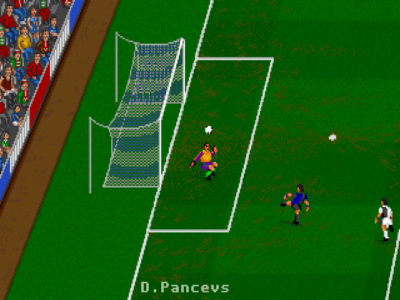
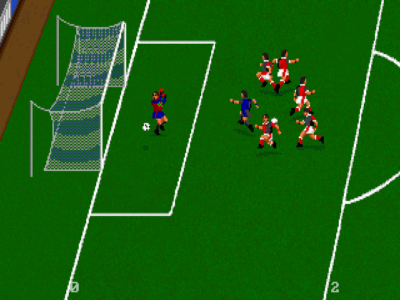
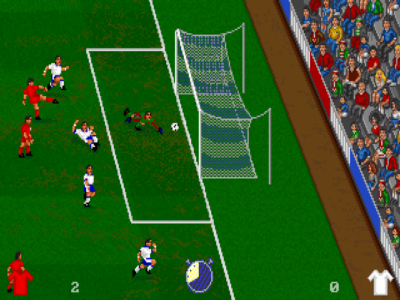
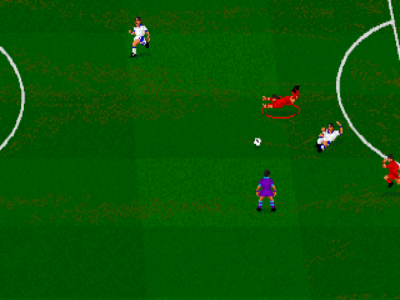
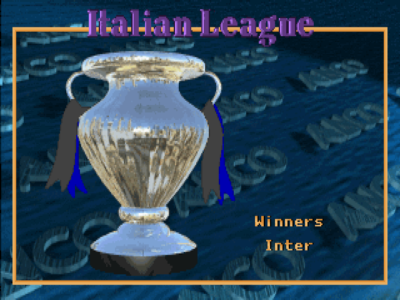
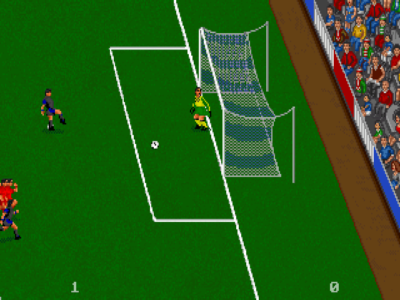

 Posts
Posts
We’re not going to talk about the horrible ball man from the title screen?
July 9, 2020 @ 2:24 am
Ha ha! It’s funny you should mention that.
Because I’ve seen that image so many times over the years (in the process of repeatedly coming back to and then abandoning this game) I must have sort of become used to it.
But just as I finished all the work on the review and hit ‘publish’ on the newspost, I did just have a moment where I was looking at it and thought, “you know, that smiling ball man is actually really creepy and weird…”
July 10, 2020 @ 8:38 am